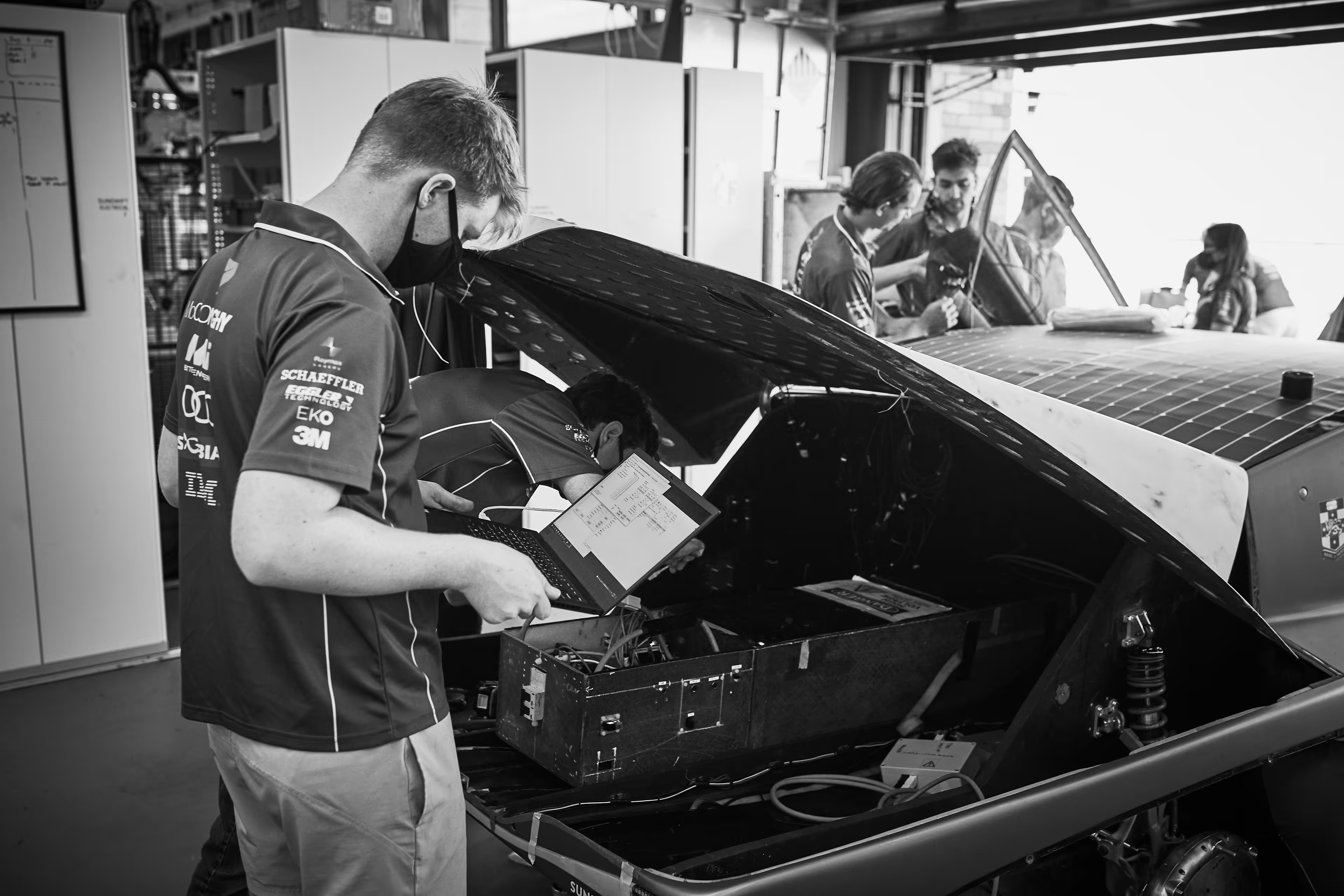Engineering applications for Term 1 2026 intake are due Sunday Week 10 of Term 3 (23rd of November).
Engineering students power the innovation behind Sunswift. From designing cutting-edge battery systems and solar energy converters to developing robust software, embedded systems, and AI models, they bring technical excellence to every corner of the car. Engineers work collaboratively across disciplines to prototype, test, and optimise systems that meet both performance and regulatory standards.
Whether you're passionate about sustainability, vehicle dynamics, or pushing the limits of what’s possible with technology, Sunswift offers a unique, hands-on opportunity to turn theory into real-world impact. Every system built is a step toward redefining the future of transport. If you're eager to apply your university knowledge to a major student-led project and collaborate with passionate peers, academics, and industry professionals, consider joining Sunswift through the VIP project website!
Note: Students studying Computer Science are welcome to apply for roles that are featured under 'Software Engineering'.
Available Positions
Alternative Energies Engineer
Requirements
- 3rd Year Student (Preferred)
- Currently pursuing an undergraduate degree in Chemical Engineering / Chemical Product Engineering
- Experienced with / interested in designing and testing hydrogen energy systems
- Solid foundation in Chemical Engineering concepts i.e. mass and energy balances (CEIC2000), and heat and mass transfer (CEIC2002)
- Able to carry out / have knowledge in equipment selection and the engineering design process (CEIC3004)
- Bonus – knowledge in process simulation with software e.g. ASPEN Plus / Hysys or any simulation software of choice (CEIC3004 and/or CEIC3005)
- Bonus – knowledge in process modeling with software e.g. MATLAB / Python or any code of choice (MATH2089 and/or MATH2018, CEIC3000)
Responsibilities
- Design, analyse and optimise an automotive PEM hydrogen fuel cell system
- Creating engineering diagrams, i.e. Block Flow Diagrams (BFDs), Process Flow Diagrams (PFDs) and Piping and Instrumentation Diagrams (P&IDs) to accurately map out the fuel cell system
- Develop and carry out fuel cell testing procedures to measure the efficiency, reliability and safety of the fuel cell system under various operating conditions to ensure compliance with Australian Design Rules (ADRs)
- Collaborate with multidisciplinary teams to ensure seamless integration of the hydrogen system with other vehicle components and energy sources
Electrical Hardware PCB Engineer
Requirements
- Pursuing an undergraduate degree in Electrical Engineering, Mechatronics, or a related field.
- Experience in PCB design, with knowledge of design rules, component placement, and signal integrity considerations.
- Familiarity with PCB manufacturing processes and the ability to troubleshoot identified PCB issues.
- Strong attention to detail and ability to work through multiple design iterations.
Responsibilities
- Design PCBs for embedded systems that will handle the control and monitoring of various vehicle subsystems, including power management, sensor data acquisition, and communication.
- Select and source appropriate components for PCBs, considering factors such as power requirements, environmental conditions, size constraints, and cost-effectiveness.
- Design electrical schematics using Altium PCB design software to ensure correct connections and functionality between components.
- Hand assembly of components onto PCB boards in the UNSW makerspace.
- Perform simulations and tests on PCB designs to ensure all design requirements are met. Prototype and test PCB designs to further ensure all electrical characteristics are within specifications and that the board operates reliably under various conditions.
- Integrate PCB with communication protocols of the car, ensuring seamless communication between sensor and user.
- Work with the Energy Systems and Mechanical department team to integrate PCBs, monitoring a plethora of systems, such as battery, solar panels, brake pressure, autonomous parking, and more.
- Coordination with the Embedded software team for firmware and rigorous testing of designs.
Energy Systems Power Distribution Engineer
Requirements
- Currently pursuing an undergraduate degree in Electrical Engineering, Mechatronics, or a related field.
- 2nd year and above.
- Knowledge about battery systems, particularly Li-ion, is preferred but not essential.
- Familiarity with software for electrical schematics (e.g., Altium).
- Strong analytical skills and attention to detail.
- Ability to work in a cross-disciplinary team and manage time effectively.
Responsibilities
- Design, construct, test and implement an innovative 800V Li-ion battery for SR8 in conjunction with our industry partner.
- Conduct simulation and analyses to model battery performance under different operating conditions, test and validate.
- Implement battery management systems (BMS) to monitor battery health, battery cycles and safe charging/discharging cycles.
- Integrate the battery with other power systems such as solar panels and hydrogen fuel cells.
- Collaborate with a multitude of departments to ensure the overall system meets the relevant ADR.
- Work in a team to design an electrical control system to interface SR8s unique tri-brid energy system.
Electrical Powertrain Engineer
Requirements
- Solid foundation and understanding in electrical circuit design-ELEC2134.
- Understanding of electric machines and power electronics- ELEC3105 (preferred).
Responsibilities
- Understanding, maintaining and diagnosing powertrain-related electrical systems.
- Collaborate closely with control engineers to ensure proper integration of motors and inverters.
- Design, optimise and analyse electrical powertrain components for a high-performance electric vehicle.
Requirements
- Currently pursuing a degree in Industrial Design, 3D Visualisation or Interaction Design.
- 2nd year or above.
- Proven design experience and projects.
Responsibilities
- Ideate, conceptualise, prototype, iterate and implement innovative design solutions.
- Create detailed sketches, 3D models, and renderings or animations to visualise concepts.
- Collaborate with departments such as Body & Chassis, Interior, Embedded Systems, Vehicle Dynamics or Software to ensure design integration and consistency.
- Create and manage accurate and consistent design documentation throughout the process.
Material Science Engineer
Requirements
- Studying a Bachelor of Engineering (Material Science) or Renewable Engineering.
- Preferably 2nd year or above.
- If studying material science, previous experience with material selection processes and software (eg. ANSYS GRANTA EDUPACK) required.
- (Optional) Experience with corrosion and fatigue analysis is beneficial.
Responsibilities
- Selecting optimal materials during the design process for components across the entire vehicle.
- Testing components that have already been installed on the vehicle for reliability and safety.
- Providing guidance on potential mitigations and solutions for at-risk components.
- Writing reports to document material selection and safety checks.
- Consulting and working closely with other departments to advise on projects related to materials.
- Developing domain knowledge across a broad range of automotive applications.
- Conducting Life Cycle Analysis for the vehicle.
Mechanical Powertrain Engineer
Requirements
- Prior experience working on drivetrain, transmission, or powertrain-related projects (internship, competition team, or personal project) - (bonus but not required).
- Proficiency in CAD
- Understanding of mechanical design principles (especially related to rotating systems).
- Ability to work independently and collaboratively in a fast-paced, interdisciplinary team.
- Strong communication skills and a problem-solving mindset.
- Ability to learn quickly and adapt to change
Responsibilities
- Collaborate closely with electrical and control engineers to ensure proper integration of motors, inverters, and transmission systems.
- Design, analyse and optimise mechanical drivetrain components for a high-performance electric vehicle, including housings, gears, couplings, shafts, and mounts.
- Maintenance and diagnosis of powertrain systems during vehicle testing
Mechanical Engineer - Interior
Requirements
- Currently pursuing an undergraduate degree in Mechanical Engineering, Aerospace Engineering, Mechatronics Engineering or a related field.
- Proficiency in CAD software (e.g., Solidworks) is essential.
- Strong understanding of common manufacturing processes.
- Bonus - knowledge in surface modelling
- Bonus - knowledge in composite materials and manufacturing.
- Bonus - proficiency in FEA.
Responsibilities
- Design and develop the interior elements of Australia’s first hydrogen powered vehicle. The interior department focuses on developing the vehicles interaction with the chassis and occupant cell, with key focuses on ergonomics, comfort and innovative designs.
- Design and manufacture bespoke elements including custom seats, steering wheel, dashboard
- Take an active role throughout the design and build process, being dependable and committed from conceptual design stages all throughout until project completion.
Mechanical Engineering - Alternative Energies
Requirements
- Currently pursuing an undergraduate degree in Mechanical Engineering, Mechatronics Engineering, Aerospace Engineering, or a related field.
- Proficiency in CAD software (e.g. SolidWorks) is essential.
- Strong understanding of mechanical design principles and engineering fundamentals.
- Ability to work collaboratively in a multidisciplinary team environment and effectively communicate technical information.
- Bonus - Experience with software such as MATLAB, Simulink, or equivalent for energy system simulations
- Bonus - Interest or experience in CFD simulations, particularly for wheel well air intake and exhaust designs.
- Bonus - Interest or experience in machining and manufacturing processes.
- Bonus - Experience with welding or willingness to learn welding skills.
Responsibilities
- Design and optimise the mechanical integration of the hydrogen fuel system, with a focus on pressure vessel design, venting systems, and safety.
- Develop mounting systems for pressure vessels, ensuring they meet space, weight, and safety requirements.
- Assist with the design and testing of hydrogen-specific safety systems such as venting valves, burst disks, and pressure relief systems.
- Model and analyse the mechanical stresses on the pressure vessel and associated components (e.g. FEA).
Mechanical Engineer - Vehicle Dynamics
Requirements
- Currently enrolled in a Mechanical Engineering program.
- Proficiency in CAD software (e.g., SolidWorks) is essential.
- Understanding of FEA software (e.g. Ansys) is highly regarded.
- Strong understanding of mechanical design principles and engineering fundamentals.
- Excellent problem-solving skills and the ability to think critically under pressure.
- Effective communication and teamwork skills, with a collaborative mindset.
- High level of motivation and a passion for sustainable technology and innovation.
- Availability to commit to regular team meetings and contribute to the project's timeline.
Responsibilities
- Develop and enhance detailed CAD models for various components of the solar car.
- Conduct Finite Element Analysis (FEA) to validate the structural integrity and optimise the performance of key mechanical components in the solar car.
- Collaborate closely with other engineering team members to integrate designs and ensure compatibility.
- Participate in design reviews and contribute innovative solutions to complex engineering challenges.
- Assist in the fabrication and assembly processes, translating CAD designs into physical components.
- Maintain open availability to support team activities, including meetings and workshops.
- Stay updated with the latest advancements in mechanical engineering and apply relevant knowledge to our projects.
Mechanical Design Engineer – Chassis and Bodywork
Requirements
- Currently pursuing an undergraduate degree in Aerospace Engineering, Mechanical Engineering, Mechatronics Engineering or a related field.
- Proficiency in CAD software (e.g. Solidworks) is essential.
- Strong understanding of common manufacturing processes.
- Bonus - knowledge in composite materials and manufacturing.
- Bonus - has taken thermodynamics (MMAN2700) and has strong interest in thermal
- Bonus - experience in FEA and/or CFD
- Bonus - robotics experience or knowledge of electrical systems.
Responsibilities
- Design and maintain detailed CAD models and assemblies of various chassis components.
- Optimise part performance and ensure compliance with Australian standards by using simulation software and real-world testing to analyse and evaluate components.
- Employ various manufacturing methods and processes to fabricate composite and non-composite parts.
- Keep up to date with advancements in materials science, manufacturing, and automotive engineering to be able to apply recent engineering innovations to current projects.
- Collaborate effectively with engineers across departments and disciplines to ensure optimal integration of mechanical and electrical subsystems.
Mechanical Engineer - Energy Systems
Requirements
- Currently pursuing an undergraduate degree in Mechanical and Manufacturing Engineering, Aerospace Engineering, Mechatronics, or a related field.
- Strong proficiency in CAD software (e.g. SolidWorks) is mandatory.
- Experience with FEA software (e.g., Ansys Mechanical, Ansys Fluent) is ideal.
- Strong understanding of common manufacturing processes in automotive engineering.
- Prior robotics experience or knowledge of electrical systems to help with subsystem integration. (Preferred)
Responsibilities
- Design and maintain detailed CAD models and assemblies of various chassis components.
- Optimise part performance and ensure compliance with Australian standards by using simulation software and real-world testing to analyse and evaluate components.
- Employ various manufacturing methods and processes to fabricate composite and non-composite parts.
- Keep up to date with advancements in materials science, manufacturing, and automotive engineering to be able to apply recent engineering innovations to current projects.
- Collaborate effectively with engineers across departments and disciplines to ensure optimal integration of mechanical and electrical subsystems.
Solar Array Characterisation Engineer
Requirements
- Currently pursuing a degree in Renewable Engineering, Photovoltaic Engineering, Electrical Engineering, Mechanical Engineering or a related field
- Experience in PCB design, C/C++/python/matlab simulation, or any other types of simulation software
- Have done SOLA 2060 or SOLA 2051 or other similar courses for students in Renewable Engineering and Photovoltaic Engineering, have done ELEC 2134 or ELEC 2133 for students in Electrical Engineering.
- Understand the physical mechanisms of solar cell and characterization methods would be ideal
- Familiar with LTSpice or some similar simulation software
- Strong problem-solving ability, strong resilience and persistence
Responsibilities
- Characterise the performance of solar array and solar cell
- Work closely with team in Renewable Makerspace, SIRF and SPREE laboratories, do fabrication and characterisation (electrical and optical) with the team.
- Test and maintain the solar array on the car embedded with MPPT
- Simulation of solar cell/array performance, analyse and maintain the solar array characterisation results.
Solar Array Manufacturing Engineer
Requirements
- Currently pursuing a degree in Renewable Engineering, Photovoltaic Engineering, Electrical Engineering, Mechanical Engineering or a related field
- Experience in CAD/Solidworks modelling (Solidworks experience is ideal)
- Strong problem-solving ability, strong resilience and persistence.
Responsibilities
- Design and develop the SR8 solar array structure, optimise the methodology of module manufacturing
- Conduct mechanical stress simulation and design the solar array stack structure
- Work closely with team in Renewable Makerspace, SIRF and SPREE laboratories, and do solar module fabrication.
- Do characterization test with team about the curved module designed for the car
Requirements
- Proficiency with various UI frameworks such as Flutter and React, or a strong desire to learn.
- Experience designing responsive user interfaces.
- Ability to quickly learn and adapt to new technologies and challenges.
- Excellent problem-solving and communication skills.
- Currently pursuing and in at least your second year of computer science, software engineering or related degree.
Responsibilities
- Design and develop the bespoke infotainment system for Sunswift 8 as well as complementary features (such as a companion app) for Sunswift 8.
- Implement responsive user interfaces using modern UI frameworks
- Design intuitive dashboards that optimise driver experience
- Build backend services to support the infotainment and mobile applications
- Collaborate with the Embedded Systems team to integrate vehicle sensor data
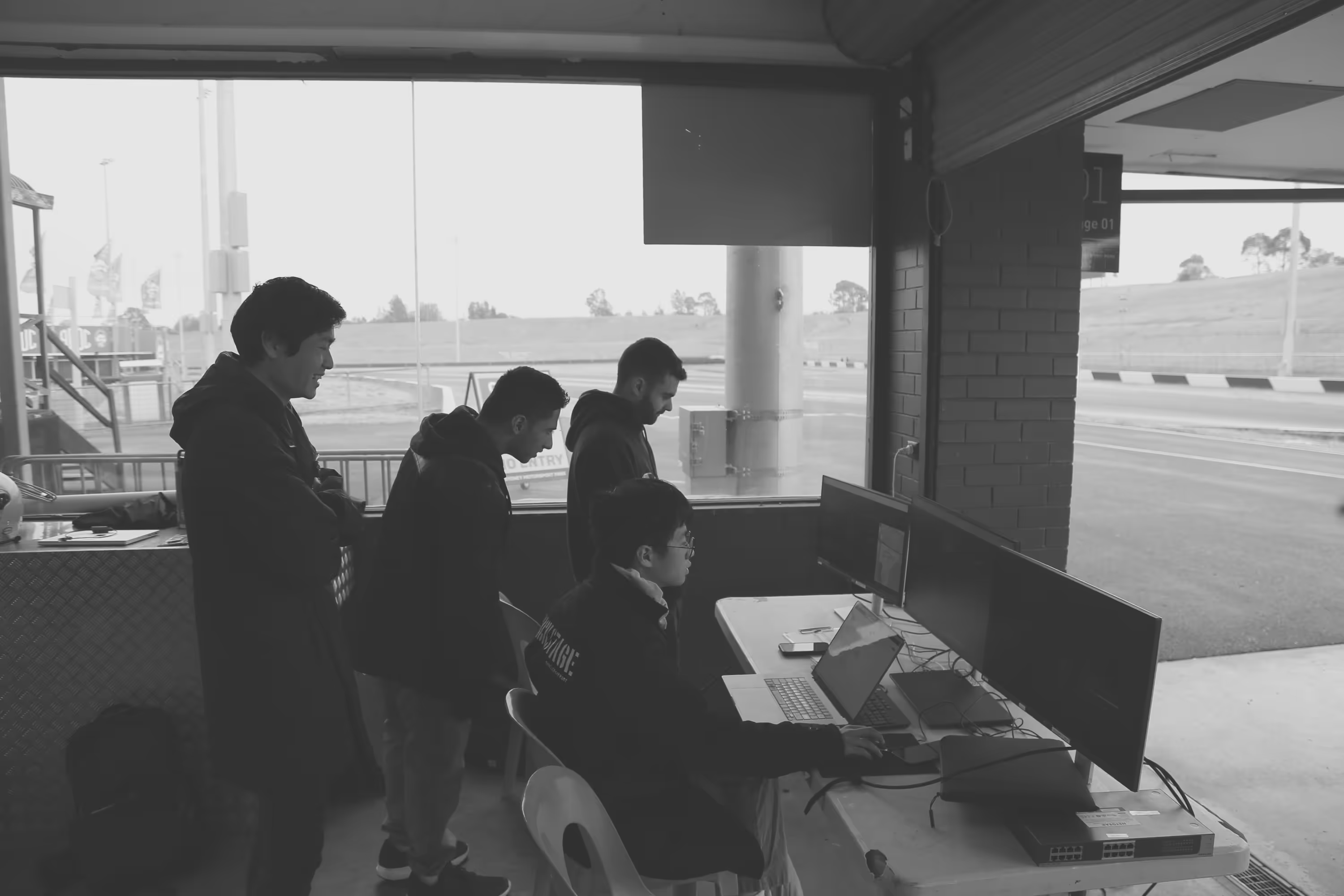
Requirements
- Currently pursuing a degree in Computer Science, Software Engineering, Telecommunications Engineering, or a related field.
- Experience in database systems, including completing COMP3311 or a similar course.
- Willingness to learn new tools such as AWS and take initiative to explore various tools to improve software architecture.
- Strong problem-solving ability, strong resilience and persistence.
Responsibilities
- Create and maintain telemetry systems for all active Sunswift vehicles.
- Coordinate with the Embedded Systems department to collect and store sensor data from active Sunswift vehicles.
- Data management using AWS applications such as EC2, Timestream, IoT Core. Additionally, assist with retrieval of data for use by engineering departments.
- Presentation of live data using Grafana dashboards (or related systems).
- Telecommunications setup for data transfer during track events and the Bridgestone World Solar Challenge. This includes using technology such as Starlink, Point-to-Point WiFi, and Wireless Mesh Networks.
Embedded Systems Software Engineer
Requirements
- Currently pursuing a degree in Mechatronics, Computer Engineering, Computer Science, or a related discipline.
- Proficiency in programming languages such as C/C++ and Python.
- Familiarity with embedded software toolchains, real-time operating systems (RTOS/QNX), and communication protocols (CAN, UART, I²C, SPI).
- Strong understanding of software design principles, modular architecture, and real-time constraints.
- Excellent problem-solving and collaboration skills, with the ability to work across software, electrical, and mechanical domains.
- Passion for sustainable automotive technologies and real-world engineering innovation.
Responsibilities
High Level Embedded Systems
- Design, develop, and implement embedded systems for Sunswift 8.
- Plan and implement high- and low-level control systems for Sunswift’s vehicles.
- Develop and deploy applications on QNX-based systems
- Contribute to overall system architecture and ensure software scalability, reliability, and maintainability.
- Collaborate with electrical and mechanical teams to ensure seamless hardware–software integration.
- Use modern development practices including GitHub version control, CI/CD, documentation, and agile workflows (e.g. Jira)
- Develop and maintain documentation for embedded systems and related software.
Low Level Embedded Systems (Firmware)
- Develop and optimize firmware for STM32 microcontrollers and other embedded platforms across multiple PCBs in the vehicle.
- Interface with hardware using UART, SPI, I²C, CAN, PWM, and related communication protocols.
- Read and interpret datasheets and hardware schematics to design reliable and efficient firmware.
- Support PCB bring-up, integration, and debugging using oscilloscopes, logic analysers, and debuggers.
- Assist in hardware component selection (sensors, actuators, compute modules) and ensure electrical compatibility.
- Collaborate closely with embedded hardware engineers to ensure stable and fault-tolerant system operation.
Performance Optimisation Engineer
Requirements
- Strong mathematical and statistical reasoning ability
- Proficiency in Python
- Familiarity with scientific libraries (NumPy,SciPy, pandas, scikit-learn, PyTorch, etc.).
- Willingness to learn optimisation methods and other mathematical methods for modelling.
- Experience with data visualisation and validation of models using empirical data.
- Excellent communication and documentation skills; you can explain complex models clearly.
- Self-driven and curious; able to work independently and learn fast.
- AWS Sagemaker / Docker experience is a bonus
- Experience in CV and/or RL is highly desired
Responsibilities
- Develop and maintain simulation tools and modelling SR8’s energy consumption
- Implement optimisation algorithms (e.g. route planning, control tuning, race strategy).
- Analyse telemetry datasets and extract insights to improve performance and efficiency.
- Build and validate predictive models using statistical or ML methods.
- Collaborate closely with other teams to translate mathematical outputs into actionable engineering decisions.
- Integrate model results into Sunswift’s telemetry, display, or simulation frameworks.
- Contribute to improving codebases for reproducibility, speed, and clarity.
Alternative Energies Software Engineer
Requirements
- Currently studying Computer Science, Software Engineering, Electrical/Mechatronics Engineering.
- Proficiency in programming languages such as C/C++ and Python
- Understanding of real-time systems or control loops (e.g. PID control).
- Ability to read circuit diagrams and interface with hardware.
- Strong Problem-Solving Skills and ability to work in a multi-disciplinary team environment
- A passion for renewable energy, sustainable transport, and cutting-edge technology is a bonus
Responsibilities
- Implement real-time data logging for the 240 W pilot-scale Proton Exchange Membrane Fuel Cell (PEMFC)
- Develop embedded or software-based systems to track critical operating parameters including voltage, current, temperature, humidity, gas pressure, and hydrogen/air flow rates during vehicle operation.
- Design control logic to operate key fuel cell subsystems, such as compressors, fans, and mass flow controllers
- Develop and integrate fault detection and safety response logic to protect the fuel cell system from hazardous conditions such as hydrogen leaks, overheating, or membrane dry-out.
- Support the development and testing of safe and reliable startup/shutdown procedures for the PEMFC system, ensuring smooth transitions between power states within the vehicle’s tribrid energy system (battery–solar–hydrogen).
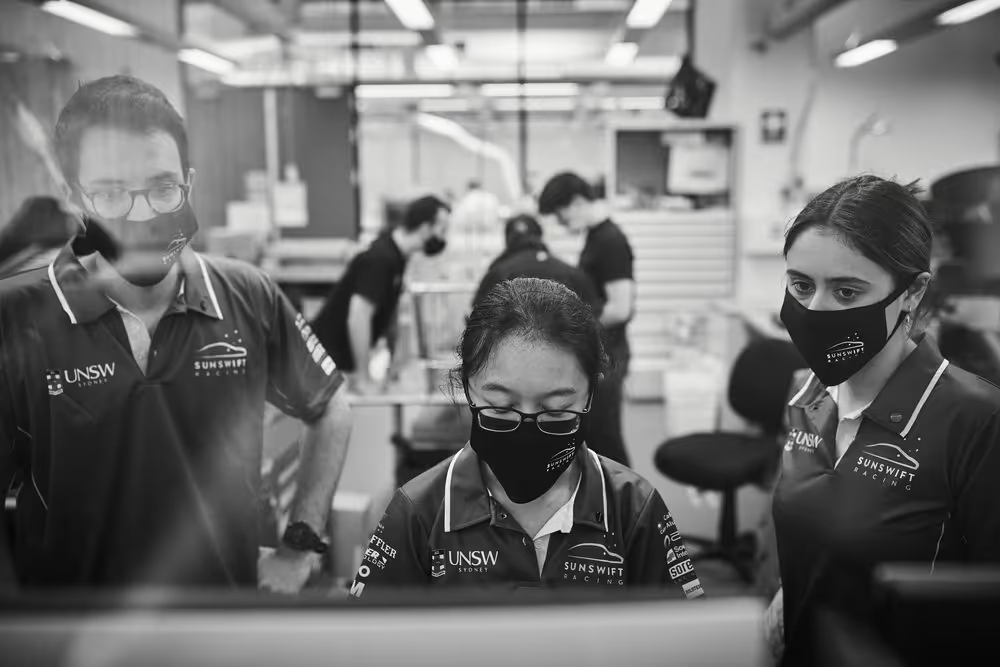
Requirements
- Currently pursuing a degree in any engineering discipline (Highly Desirable: Aerospace, Mechanical, Mechatronics, Electrical).
- Excellent teamwork and communication skills.
- Experience in multidisciplinary engineering projects.
- Passionate, dedicated, and eager to learn! Since Systems Engineering isn't typically offered at the undergraduate level, this role provides a rare opportunity to gain practical, hands-on experience in this field.
Responsibilities
- Coordinate the integration and interfacing between projects and departments, ensuring coherence by collecting all relevant requirements and constraints.
- Collaborate with teams to ensure compliance with various guidelines, contributing to the vehicle's regulatory adherence and road legality.
- Oversee the creation and execution of Verification & Validation processes to ensure that all vehicle components meet design requirements and safety regulations.
- Oversee Mechanical drawings to ensure compliance with external requirements.
- Utilise Model Based Systems Engineering methodologies to simulate and optimise subsystems.
.avif)
.avif)
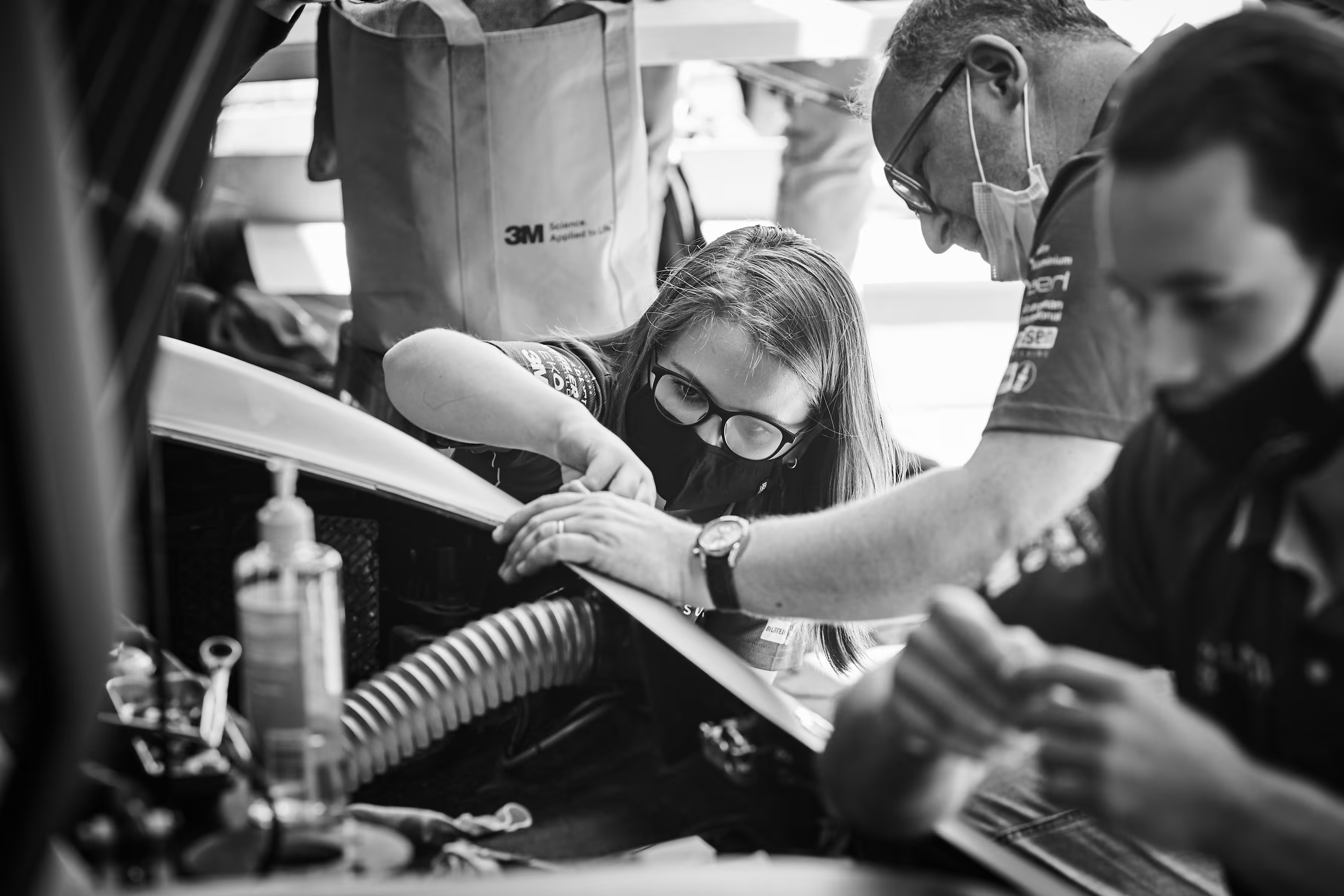



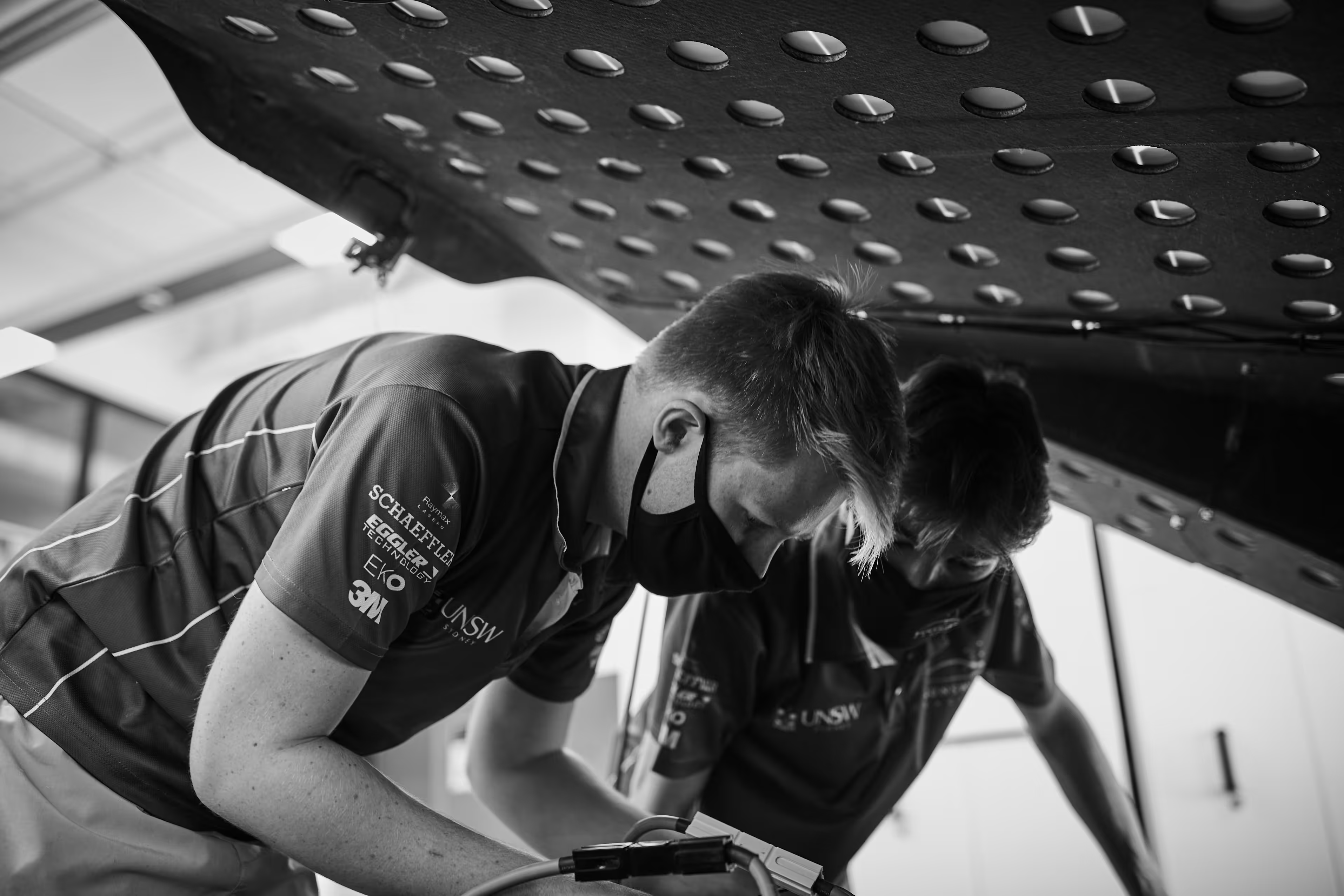

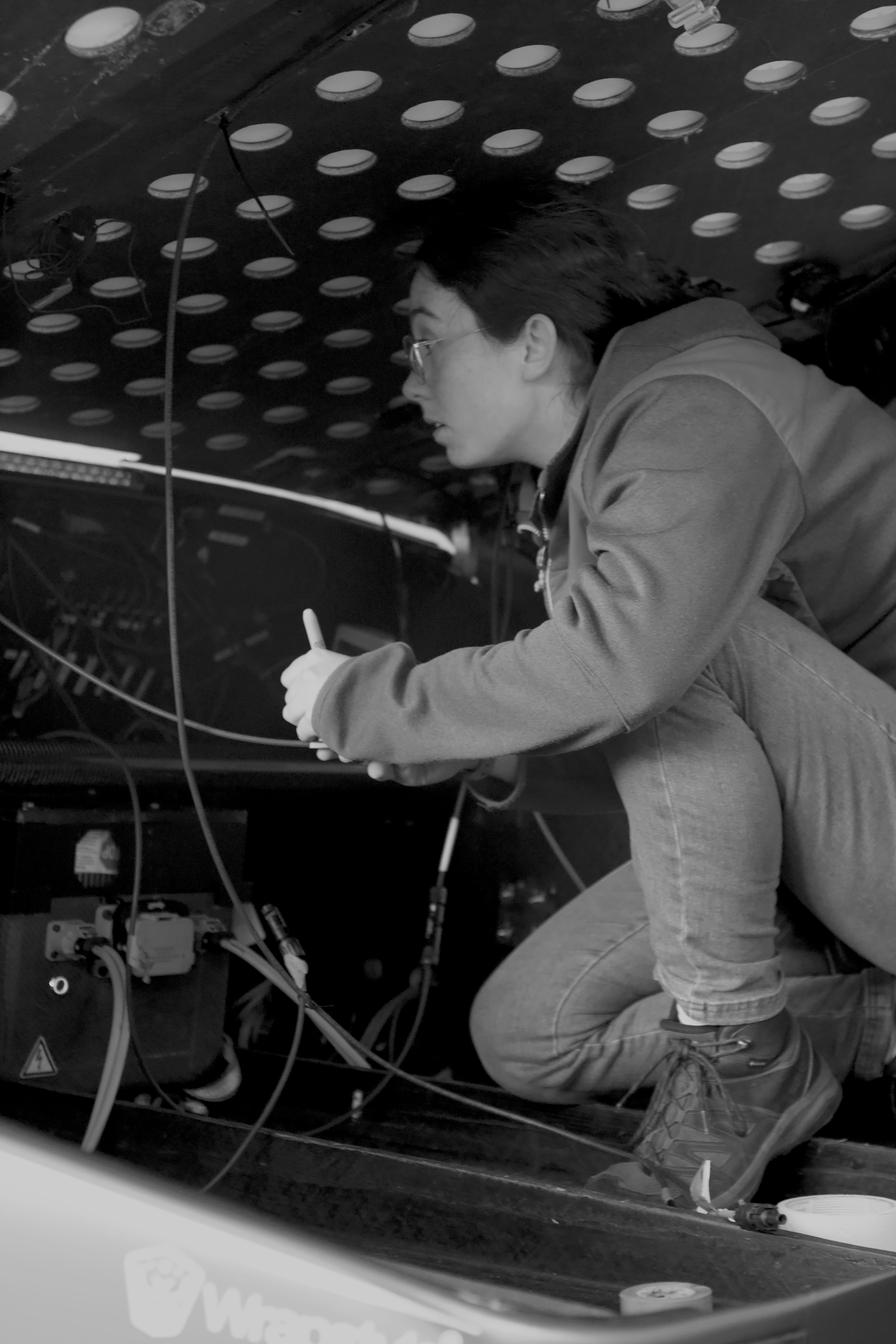



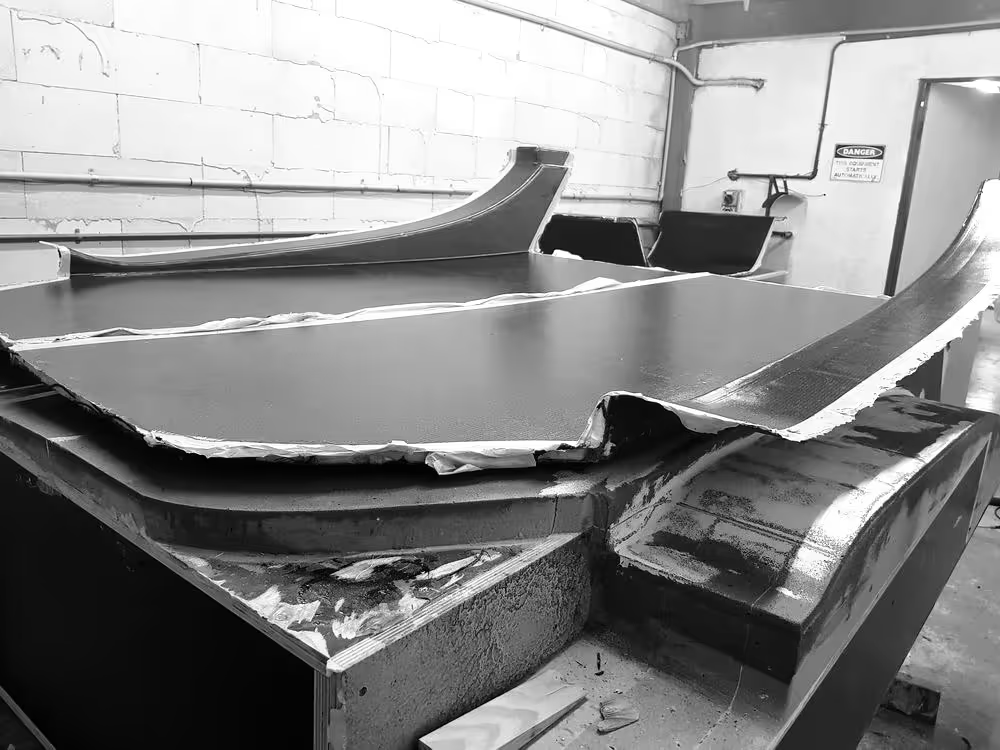

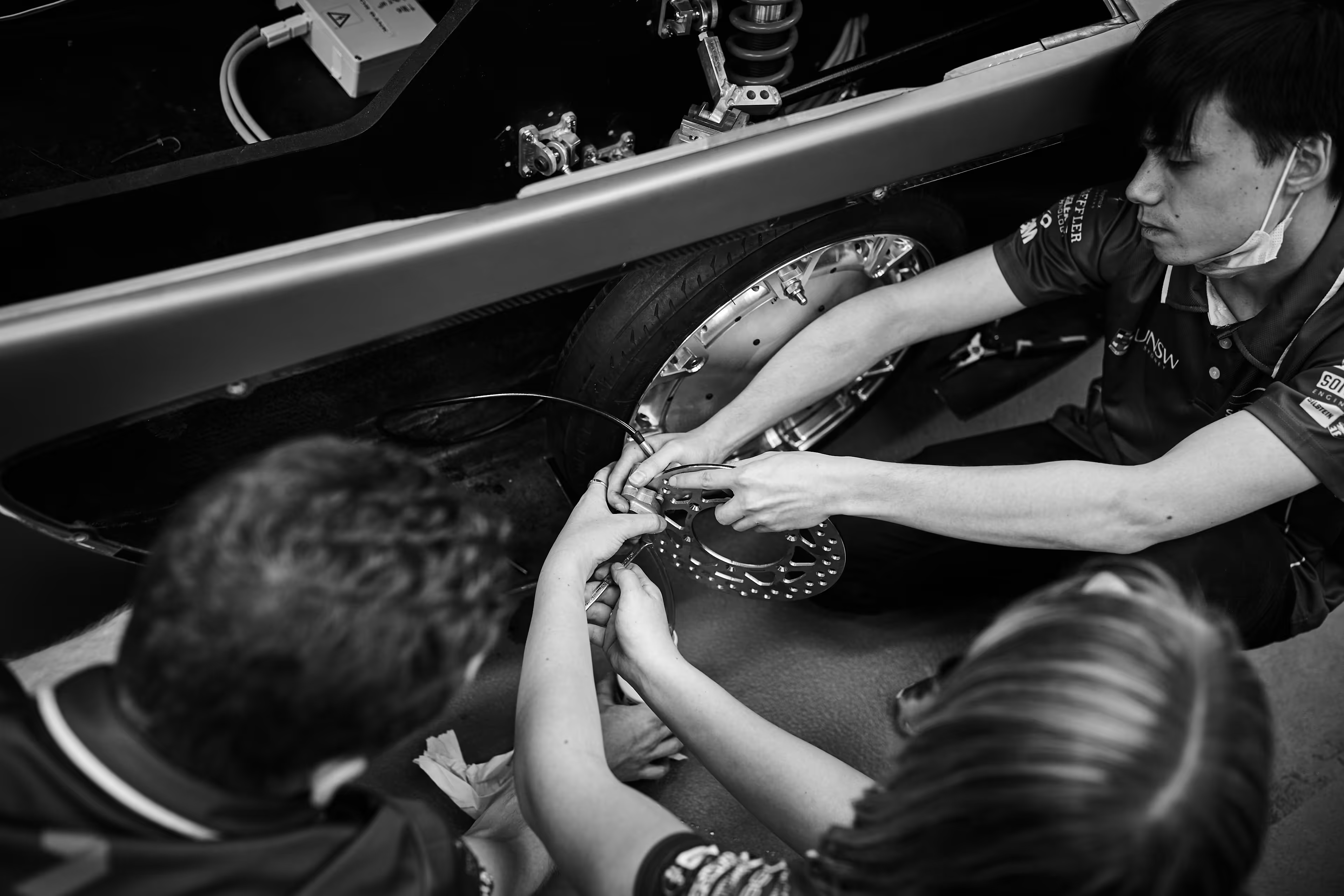

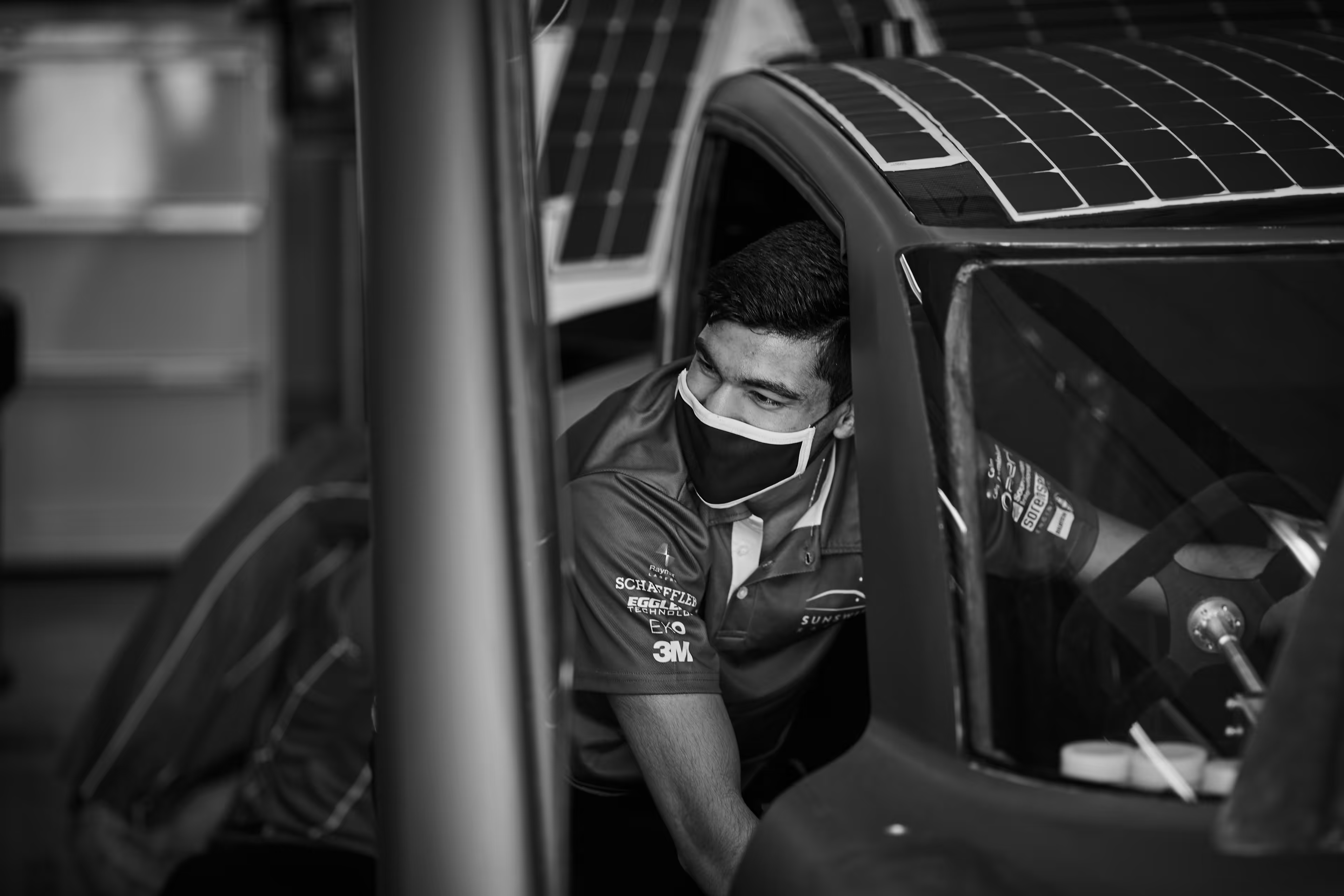

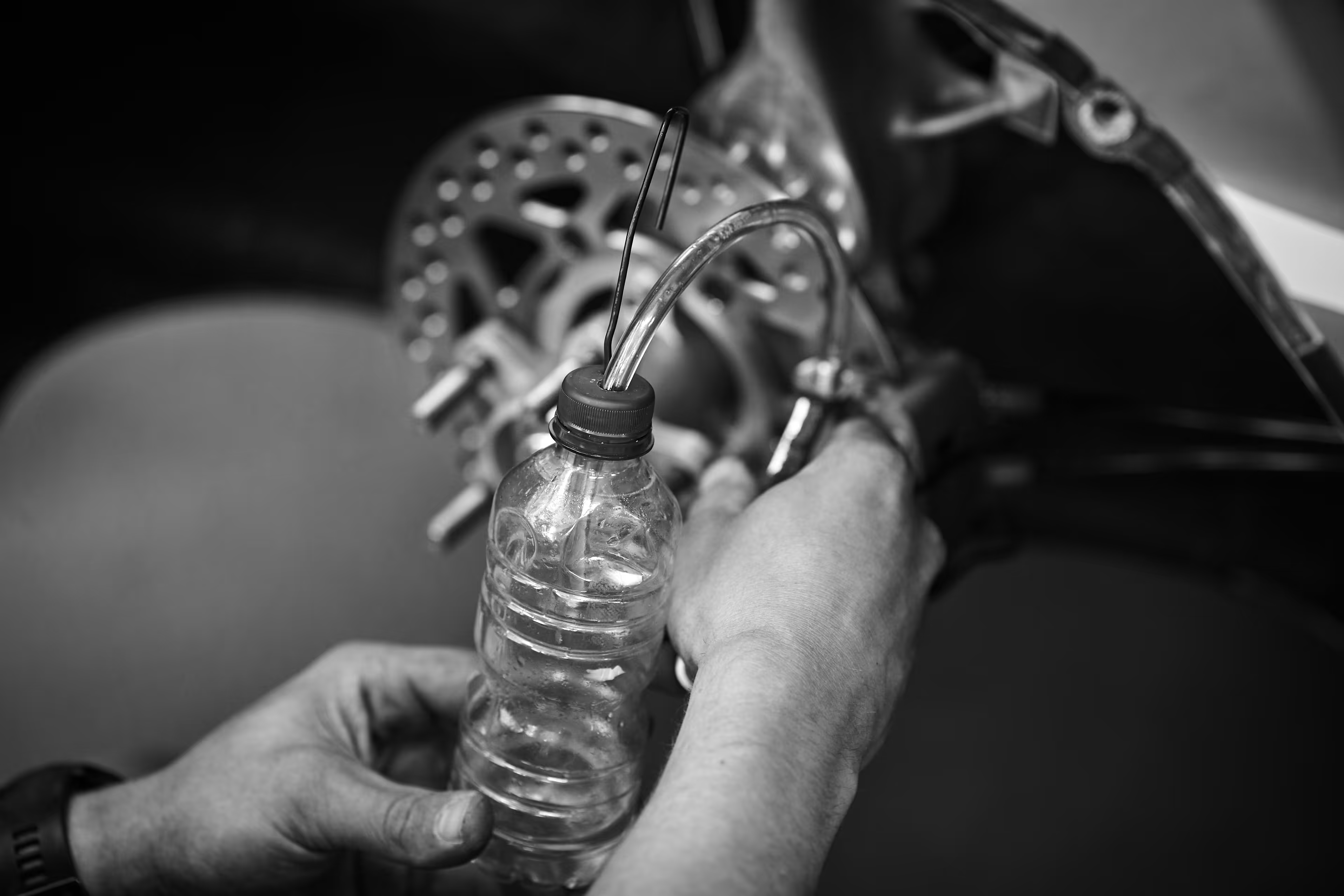

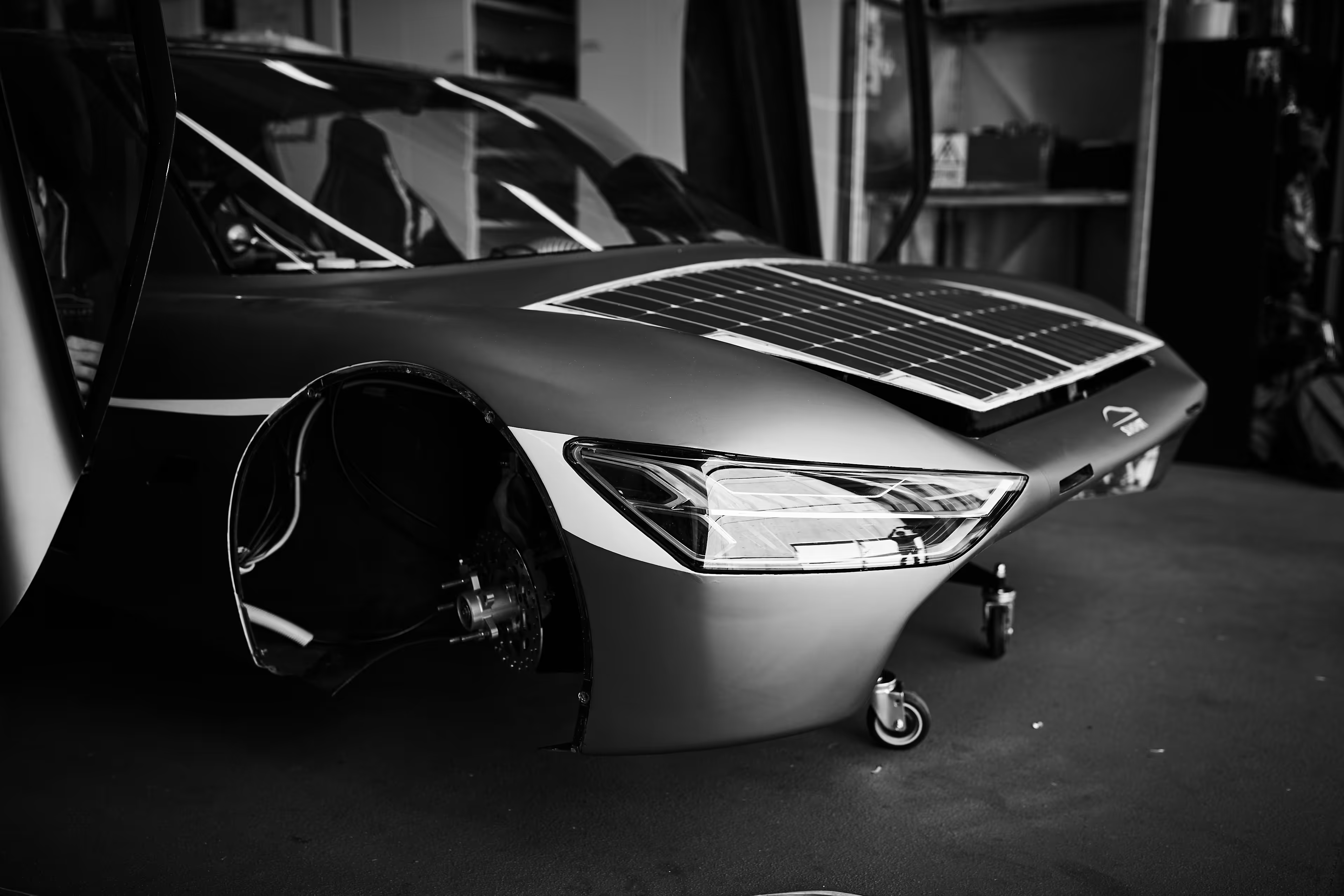

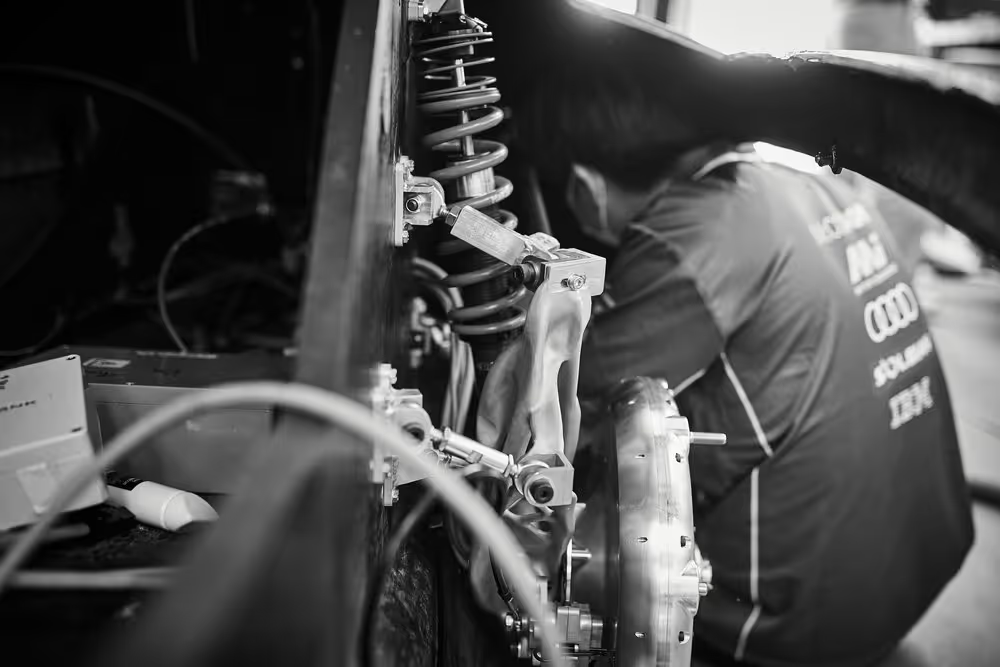

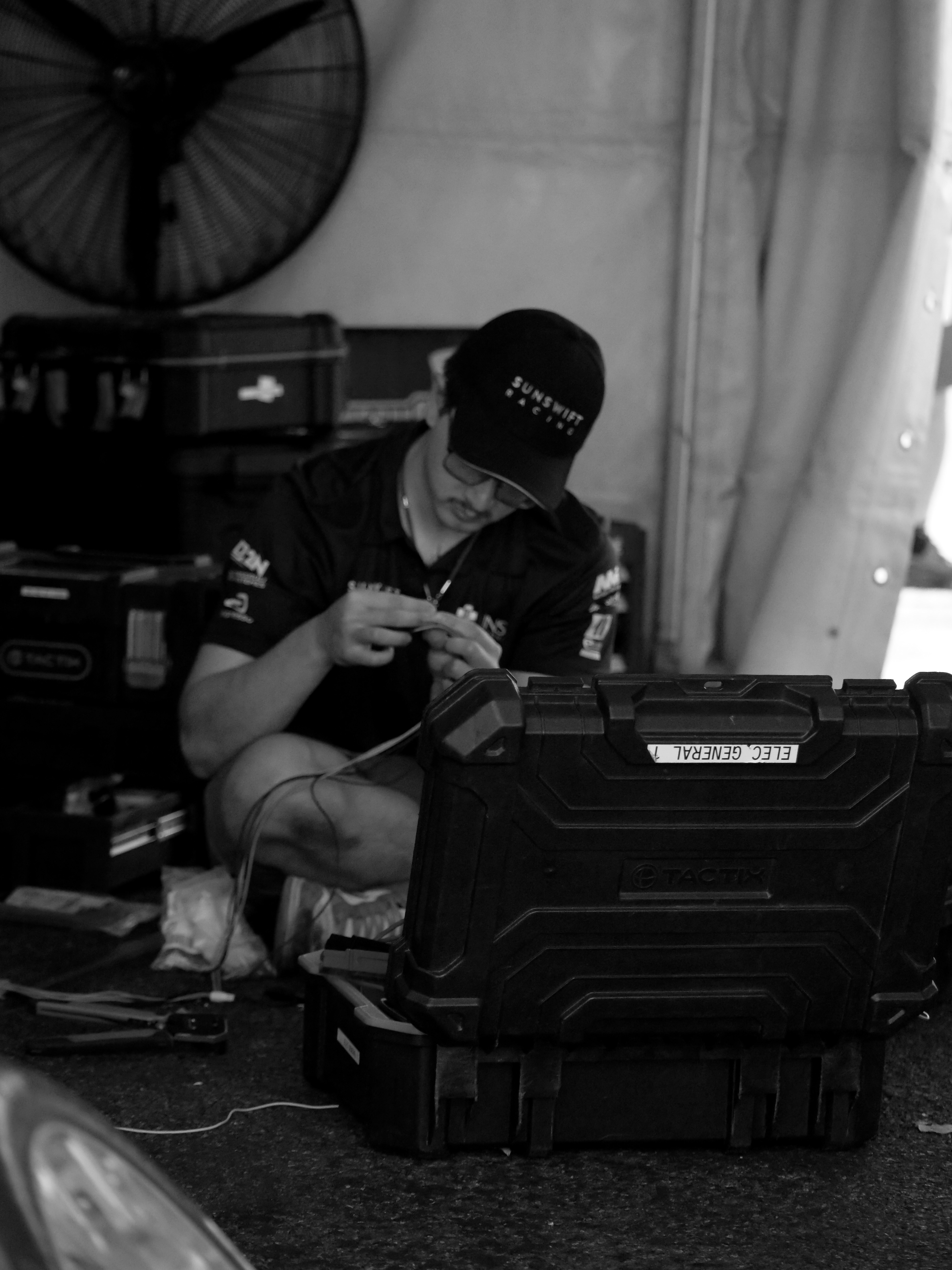



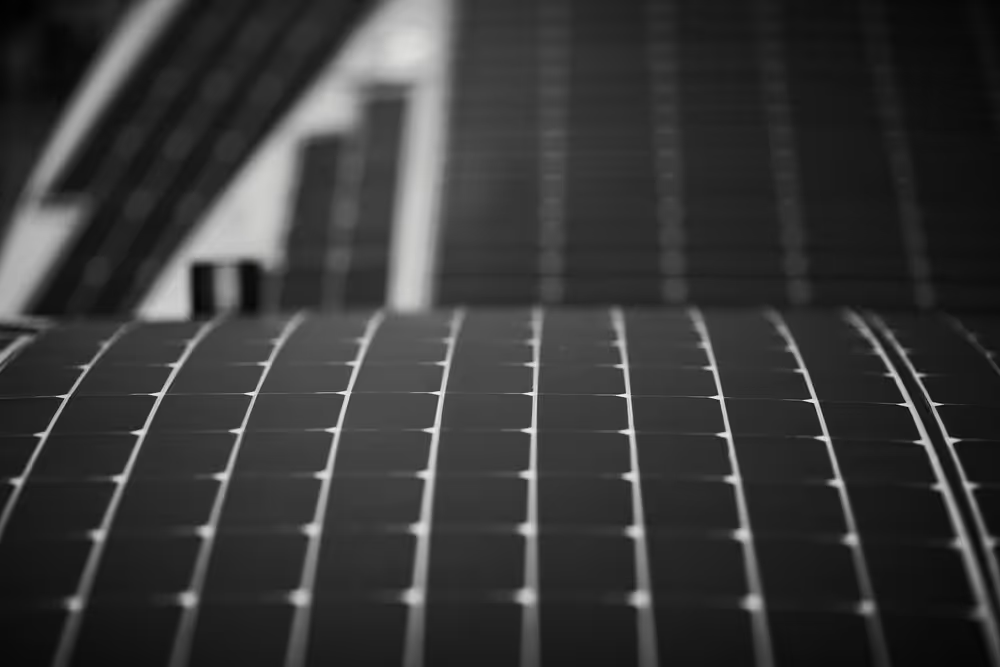

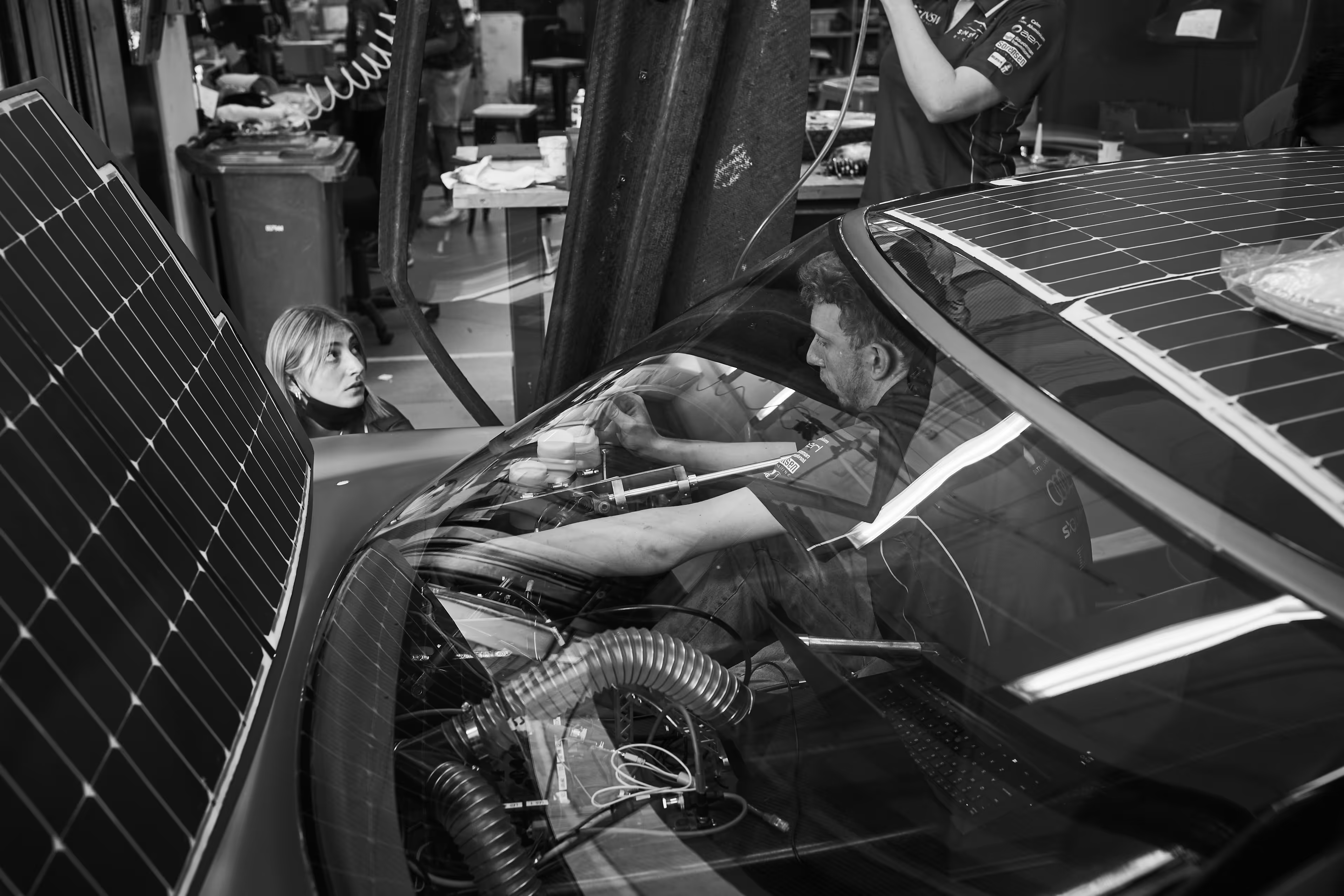





.jpg)
.jpg)
